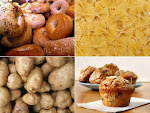8.2 Summary
LIGHT REACTION
-light energy
-electromagnetic energy travel in waves
-Wavelength- distance between 2 waves
-electromagnetic spectrum: range of type of rays (short to large)
-pigments: chemical compounds that causes color.
-chloroplast allows some to pass through and others to reflect
-green reflects, causing the color of the leaves.
-paper chromatography can be used to observe the different pigments in a leaf.
-photosystems contain hundreds of pigment molecules, which act like light gathering panels
-when energy is absorbed, electron gain and lose energy while the energy bounce from place to place and is finally trapped by the primary electron acceptors.
8.2 Vocabulary
Wavelength is the distance between 2 adjacent waves.
Electromagnetic spectrum is the range in types of electromagnetic energy from the short gamma rays to the long radio waves.
Pigments are what make a substance’s color.
Paper chromatography is a laboratory technique that can be used to observe the different pigments in a green leaf.
Photosystems are clusters within the thylakoid membrane hat chlorophylls and other molecules are arranged in.
8.2 Concept Check
1. Explain why a leaf appears green.
A leaf appears green because chloroplast pigments do not absorb green light well, causing the green light to bounce back (reflect) and not to be absorbed.
2. Describe what happens when a molecule of chlorophyll a absorbs light?
When a molecule of chlorophyll absorbs light, one of the pigment’s electrons will gain energy, but since the high energy stage is unstable, it will fall to a low energy state again, which will transfer its energy to the next electron. After a while, the energy will arrive at the center of the photosystem, which will cause the electron accepter to trap the excited electron from the chlorophyll a molecule.
3. Besides oxygen, what two molecules are produced by the light reactions?
Besides oxygen, NADPH and ATP and produced by light reactions.
4. Where in the chloroplast do the light reactions take place?
The light reactions take place in the thylakoid membranes in the chloroplast.
Monday, November 10, 2008
8.1
8.1 Summary
PHOTOSYNTHESIS
-takes place in chloroplast which contain chlorophylls (green color)
-Chloroplasts are in mesophyll cells.
-Structure is important to the function of chloroplasts
-inner membrane — encloses thick fluid of stroma with thylakoids inside
-outer membrane
-carbon dioxide + water = glucose + oxygen
-electrons in water are boosted uphill by the energy of sunlight. Produces sugar molecules with carbon dioxide and hydrogen.
-2 stages
-Calvin cycle
-light reaction
8.1 Vocabulary
Chloroplast is the cellular organelle where photosynthesis takes place at
Chlorophylls are compounds that chloroplasts contain, which gives these organelles a green color.
Stroma is the thick fluid that the inner membrane of a chloroplast contains.
Thylakoids are disk-shaped sacs that are suspended in the stroma.
Light reaction converts the energy of the sunlight to chemical energy.
Calvin cycle makes sugar from the atoms in carbon dioxide plus the hydrogen ions and high-energy electrons carried by NADPH.
8.1 Concept Check
1. Draw and label a simple diagram of a chloroplast that includes the following structures: outer and inner membranes, stroma, thylakoids.
2. What are the reactants for photosynthesis? What are the products?
Reactants of photosynthesis are carbon dioxide and water; the products are glucose and oxygen.
3. Name the two main stages of photosynthesis. How are the two stages related?
The 2 main stages of photosynthesis are the light reaction and the Calvin cycle.
They are related because they happen in the photosynthesis process, transfer one substance into another and transfers substances between the 2 processes.
PHOTOSYNTHESIS
-takes place in chloroplast which contain chlorophylls (green color)
-Chloroplasts are in mesophyll cells.
-Structure is important to the function of chloroplasts
-inner membrane — encloses thick fluid of stroma with thylakoids inside
-outer membrane
-carbon dioxide + water = glucose + oxygen
-electrons in water are boosted uphill by the energy of sunlight. Produces sugar molecules with carbon dioxide and hydrogen.
-2 stages
-Calvin cycle
-light reaction
8.1 Vocabulary
Chloroplast is the cellular organelle where photosynthesis takes place at
Chlorophylls are compounds that chloroplasts contain, which gives these organelles a green color.
Stroma is the thick fluid that the inner membrane of a chloroplast contains.
Thylakoids are disk-shaped sacs that are suspended in the stroma.
Light reaction converts the energy of the sunlight to chemical energy.
Calvin cycle makes sugar from the atoms in carbon dioxide plus the hydrogen ions and high-energy electrons carried by NADPH.
8.1 Concept Check
1. Draw and label a simple diagram of a chloroplast that includes the following structures: outer and inner membranes, stroma, thylakoids.
2. What are the reactants for photosynthesis? What are the products?
Reactants of photosynthesis are carbon dioxide and water; the products are glucose and oxygen.
3. Name the two main stages of photosynthesis. How are the two stages related?
The 2 main stages of photosynthesis are the light reaction and the Calvin cycle.
They are related because they happen in the photosynthesis process, transfer one substance into another and transfers substances between the 2 processes.
Subscribe to:
Posts (Atom)
